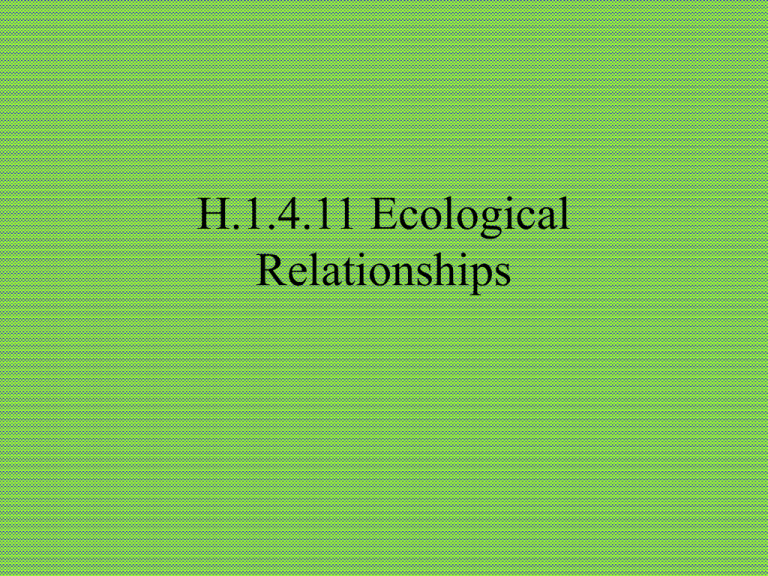H.1.4.11 Ecological Relationships
advertisement

H.1.4.11 Ecological Relationships Factors that control Population 1. Competition 2. Predation 3. Parasitism 4. Symbiosis These factors help maintain population numbers and bring about a ‘balance of nature’ 2 Population A group of individuals of the same species living together in a habitat. They live in populations for the following reasons: • Their habitat provides food and shelter • Individuals are safer in a group • The availability of a mate for breeding purposes 3 Competition When organisms of the same or different species ‘fight’ for necessary resources that are in short supply. Intra-specific competition: Between members of the same species i.e. within a species Inter-specific competition: Between members of different species 4 Competition for resources Plants compete for light, water, minerals and space Animals compete for food, water, shelter, territory and mates 5 Learning check What is meant by a population? A group of individuals of the same species living together in a habitat Explain what is meant by competition. When organisms of the same or different species ‘fight’ for necessary resources that are in short supply. 6 Two types of competition 1. Contest Competition involves an active physical confrontation between two organisms – one wins Example two dogs fighting over a bone One may have stronger muscles and sharper teeth and so win the bone Another example 7 Two stags fighting over mating rights Two types of competition 2. Scramble Competition This is where each organism tries to acquire as much of the resource as possible e.g. an ivy plant and a hawthorn tree may compete for light. The ivy uses adventitious roots to grip the hawthorn and climb higher. 8 adventitious roots adventitious root: root that does not develop from the radicle e.g. (a) climbing roots of ivy, (b) roots of cuttings that arise from a node. 9 Scramble competition in action 10 Learning check What do plants and animals compete for? Plants • compete for light, water, minerals and space Animals • compete for food, water, shelter, territory and mates 11 Competition & Population Size • Restricts population size • Only successful competitors will survive and reproduce • Is a driving force behind evolution i.e. adaptive techniques (sharp teeth of carnivores or climbing abilities in ivy) develop in response to the need to survive competition 12 How do animals survive competition? They adapt to their environment by: • Changing their feeding habits • Camouflage • Producing protective coats • Moving away from over-populated areas • Reproductive strategies e.g. Kangaroo can carry up to three offspring 1. Joey 2. New born baby (2.5 cm long) 3. Fertilized Egg sitting in tubes to go to womb 13 How do plants survive competition? e.g. weeds (i.e. plants growing in a place where they are not wanted) These compete with other plants for water, minerals and light and will survive because: • They produce large numbers of seeds • Seeds germinate quickly, even in poor soil • Plants thrive even in poorer soil conditions 14 Learning check Name and explain and give examples of two types of competition. 1. Contest Competition involves an active physical confrontation between two organisms – one wins e.g. two dogs fighting over a bone 2. Scramble Competition This is where each organism tries to acquire as much of the resource as possible e.g. an ivy plant and a hawthorn tree may compete for light. 15 Adaptive Techniques Adaptive techniques are adaptations which have evolved (developed) in response to the need to survive competition e.g.1 sharp teeth of carnivores e.g.2 climbing abilities in ivy 16 Learning check • How do animals and plants survive predation? Animals • Feeding habits • Camouflage • Protective coats • Move away from over-populated areas • Reproductive strategies Plants • Produce large numbers of seeds • Seeds germinate quickly • Plants thrive even in poorer soil conditions17 Predation predation: the act, of some animals (predators), of capturing and killing other animals for food. predator: animal that hunts, captures and kills other animals (prey) for food. Predators have evolved adaptive techniques to survive, e.g. wolf has keen hearing and eyesight, strong muscles, sharp teeth, 18 camouflage and hunts in packs. Positive Effects of Predation 1. Predation stabilises the community 2. Predators control the number of herbivores and so prevent overgrazing 3. Predators eliminate the less well adapted (weaker) prey 19 Adaptations of Predators • Keen senses and sharp teeth • Catch easiest prey – old and sick (less energy used) • Change diet to suit prey available e.g. foxes • Live and hunt in packs • Migrate to where prey is plentiful • Camouflage 20 Adaptations of Predators Three examples of Adaptations of Predators 1. Hawks have excellent eye sight 2. Ladybirds have strong mouth parts 3. Cheetahs can run at 60 km/h 21 Learning check Explain the terms predation and predator. predation: the act, of some animals (predators), of capturing and killing other animals for food. predator: animal that hunts, captures and kills other animals (prey) for food. 22 Adaptations of Prey • • • • Plants may have thorns, spines or stings Nasty taste when eaten e.g. giant hogweed Are faster than their predator Staying in herds or flocks – safety in numbers • Camouflage – greenfly, stick insects 23 Adaptations of Prey Three examples of Adaptations of Prey 1. Frogs are well camouflaged 2. Zebras have strips, when in a group lions can’t distinguish where one ends & another begins. 3. Ladybirds contain large amounts of Formic acid so they are unpalatable to taste 24 Predator / Prey relationship The populations of wolves and deer are interconnected. Both have evolved adaptive techniques to survive e.g. wolves – keen hearing and eyesight, strong muscles, sharp teeth, camouflage and hunt in packs. deer – keen hearing and eyesight, quick to turn and run and camouflage to evade the wolves. 25 Predator / Prey relationship (Wolf / Deer in Alaska) Notes 1 2 3 4 5 6 7 8 9 26 Notes on graph 1. When the deer population increased, the wolf population had more food and increased too. graph 2. As the wolf population increased, the number of deer being killed increased – graph resulting in a decline in the deer population 3. When the deer population declined, there was less food for the wolves and they declined in numbers too. graph 4. This led to an increase in the deer population. graph 27 Notes on graph 5. This cycle continued over years and had obviously found a natural balance to do with availability of food for both populations. graph 6. When the wolf population was drastically reduced due to hunting, the resulting explosion of the deer population led to overgrazing of the vegetation. graph 7. This produced huge mortality and emigration in the deer population with a collapse of the relationship. graph 28 Notes on graph 8. After the banning of hunting, a balance was slowly re-established in the two populations. graph The populations are controlled by negative feedback, where a drop in numbers is generally self-correcting. Over a long period of time, the deer evolve structures and behaviours to survive predation better, e.g. quicker reactions, etc. The wolves also evolve better predation techniques 29 to cope with the evolving prey. Learning check Give three examples of Adaptations of Prey 1. Frogs are well camouflaged 2. Zebras have strips, when in a group lions cant distinguish where one ends & another begins. 3. Ladybirds contain large amounts of Formic acid so they are unpalatable to taste 30 In Summary Predator/Prey relationships As Prey Predators .As there are more predators the prey will Hence predators Eventually numbers of prey will increase, starting the cycle once more. 31 Alternative graph of predator / prey relationship 32 Parasitism One organism, the parasite, benefits from another, the host, and does harm to it e.g. fleas on a dog (ectoparasites), liverfluke in cattle/sheep (endoparasites). Parasites do harm to their hosts but usually do not kill them too quickly. 33 Symbiosis Symbiosis (‘living together’) – where two organisms of different species have a close, specific relationship with each other where at least one of them benefits. Parasitism is a form of symbiosis 34 Examples of Symbiosis • A lichen is composed of an alga and a fungus intertwined. The alga obtains support and a mineral supply from the fungus; the fungus obtains food from the alga. • Nitrogen-fixing bacteria in the nodules of leguminous plants (legumes): The bacteria make nitrogen compounds needed by the plant and the plant makes carbohydrates and other food material needed by the bacteria • Bacteria living in the colon produce vitamin B2 and vitamin K. The body absorbs these vitamins. 35 Learning check • Explain what is happening at each of the numbered locations on this graph. 36 Need to know • Name factors that can control populations. Define and give one example of the following factors: 1. Competition 2. Predation 3. Parasitism 4. Symbiosis 37 END 38





